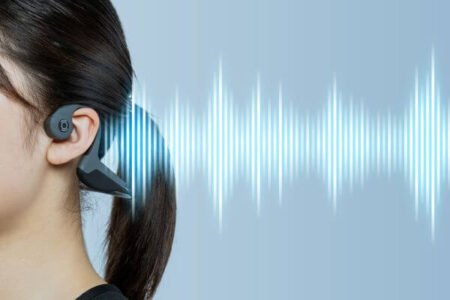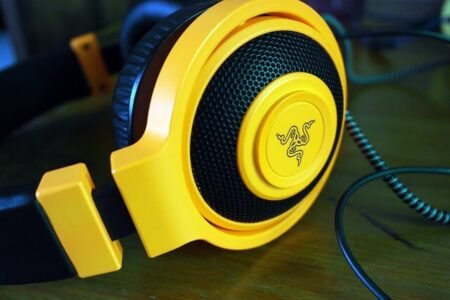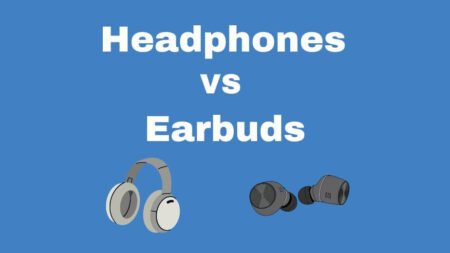Bone conduction headphones are a type of audio device that allows you to listen to music or other audio without blocking your ears. Instead of using traditional speakers or earbuds, bone conduction headphones use vibrations to transmit sound waves directly to your inner ear through your skull bones. This technology was originally developed for use in hearing aids but has since been adapted for use in headphones.
One of the main benefits of bone-conduction headphones is that they allow you to remain aware of your surroundings while listening to music or other audio. This can be especially useful for athletes who need to be able to hear traffic or other environmental sounds while running or cycling. Additionally, bone-conduction headphones can be a good option for people who have trouble wearing traditional headphones due to discomfort or hearing loss.
Overall, bone conduction headphones offer a unique listening experience that can be both comfortable and practical. While they may not be the best option for audiophiles or those looking for the highest quality sound, they can be a great choice for people who value safety, comfort, and convenience.
Understanding Bone Conduction
What is Bone Conduction
Bone conduction is a hearing mechanism that bypasses the outer and middle ear and sends sound vibrations directly to the inner ear via the bones in the skull. This is in contrast to air conduction, which is the traditional method of hearing where sound waves travel through the ear canal and vibrate the eardrum, which then transmits the vibrations to the inner ear.
Bone conduction headphones work by using transducers that convert electrical signals into vibrations that are transmitted through the bones in the skull to the inner ear. The inner ear then interprets these vibrations as sound. This makes bone-conduction headphones an excellent option for people with hearing impairments or those who want to listen to music while still being aware of their surroundings.
Difference Between Air and Bone Conduction
The main difference between air conduction and bone conduction is the path that sound waves take to reach the inner ear. With air conduction, sound waves travel through the air and enter the ear canal, where they vibrate the eardrum. The vibrations are then transmitted to the inner ear via the middle ear bones.
In contrast, with bone conduction, sound waves are transmitted through the bones in the skull directly to the inner ear. This allows people with hearing impairments or other ear-related issues to hear sounds that they might not be able to hear through air conduction.
One of the benefits of bone conduction is that it allows people to hear sounds while still being aware of their surroundings. This is because bone-conduction headphones do not block the ear canal, which means that users can still hear sounds from their environment. This makes them an excellent option for people who need to be aware of their surroundings while listening to music or taking phone calls.
In summary, bone conduction is a hearing mechanism that bypasses the outer and middle ear and sends sound vibrations directly to the inner ear via the bones in the skull. Bone conduction headphones use transducers to convert electrical signals into vibrations that are transmitted through the bones in the skull to the inner ear. This makes them an excellent option for people with hearing impairments or those who want to listen to music while still being aware of their surroundings.
Design and Comfort
The Open-Ear Design
One of the most notable features of bone-conduction headphones is their open-ear design. Unlike traditional headphones that cover the ears, bone conduction headphones use earpieces placed over the jaw or cheek area to send vibrations to the inner ear. This design allows users to hear their surroundings while still enjoying their music or audio.
The open-ear design also makes bone-conduction headphones a great option for outdoor activities, such as running or cycling, as users can remain aware of their surroundings and stay safe. Additionally, some bone-conduction headphones are designed with reflective materials or LED lights to further enhance visibility during low-light conditions.
Comfort and Secure Fit
Comfort and secure fit are essential factors to consider when choosing bone-conduction headphones. Since the earpieces do not cover the ears, some users may experience discomfort or irritation from prolonged use. It is important to look for headphones with soft and flexible earpieces that can adjust to the shape of the user’s face.
A secure fit is also crucial to ensure that the headphones stay in place during physical activity. Some bone-conduction headphones come with adjustable straps or clips to keep them in place, while others use a wrap-around design that fits snugly behind the head. It is important to find a comfortable fit and security to avoid any distractions or discomfort during use.
Overall, bone conduction headphones offer a unique and innovative design that provides a comfortable and secure fit for users. The open-ear design allows users to remain aware of their surroundings while still enjoying their music or audio, making them a great option for outdoor activities.
Sound Quality and Performance

As a music lover, I was initially skeptical about bone conduction headphones’ sound quality and performance. However, after using them for a while, I can confidently say that they are an excellent alternative to traditional headphones.
Audio Quality
Bone conduction headphones use vibrations to transmit sound directly to the inner ear, bypassing the eardrum. The audio quality is not as good as that of traditional headphones, but it is still quite good. The sound is clear and crisp, and the bass is decent. However, if you are an audiophile who is looking for the best sound quality, you may be disappointed.
Vibration and Sound Leakage
One of the most significant advantages of bone-conduction headphones is that they allow you to hear your surroundings while listening to music. This is because they do not block your ear canal, and the sound is transmitted through your bones. However, this can also be a disadvantage because the vibrations can be felt by those around you, and the sound can leak out. Therefore, it is not recommended to use it in quiet environments, such as libraries or offices.
In conclusion, bone-conduction headphones are a great option for people who want to listen to music while still being aware of their surroundings. The audio quality is good, but not as good as that of traditional headphones. The vibrations can be felt by those around you, and the sound can leak out, so they are not recommended for quiet environments. Overall, those headphones are a great alternative to traditional headphones, and I would highly recommend them.
Technology and Features
As bone-conduction headphones gain popularity, manufacturers are incorporating advanced technology and features to make them more versatile and user-friendly. In this section, I will discuss two key features of bone-conduction headphones: Bluetooth connectivity and water resistance, and durability.
Bluetooth Connectivity
Most bone-conduction headphones come with Bluetooth connectivity, allowing users to enjoy wireless audio streaming from their smartphones, tablets, or other Bluetooth-enabled devices. Bluetooth 5.1 is the latest version of the technology, offering faster data transfer rates, better range, and improved power efficiency compared to previous versions. This means that you can enjoy high-quality audio with minimal lag and interference.
Some of them also support multipoint connectivity, which allows you to connect to two devices simultaneously. This is useful if you want to switch between your phone and laptop without having to disconnect and reconnect each time.
Water Resistance and Durability
Bone conduction headphones are designed to be lightweight and comfortable, but they also need to be durable enough to withstand everyday wear and tear. Many models are water-resistant, which means they can withstand splashes of water and sweat. Some are even fully waterproof, allowing you to use them while swimming or showering.
When it comes to durability, look for headphones with sturdy frames and flexible bands that can withstand bending and twisting. Some models also come with reinforced cables and connectors to prevent breakage.
In terms of battery life, most of those headphones offer around 6-8 hours of playback on a single charge. Some models also come with quick charging capabilities, allowing you to get a few hours of playback with just a few minutes of charging.
Overall, it offers a unique listening experience that is perfect for outdoor activities or situations where you need to stay aware of your surroundings. With the latest Bluetooth technology and durable designs, these headphones are becoming a popular choice for music enthusiasts and athletes alike.
Usage and Safety
As with any technology, it is important to understand the usage and safety guidelines for bone-conduction headphones. This section will cover some important points to consider.
For Sports and Fitness
Bone conduction headphones are popular among sports and fitness enthusiasts because they allow for situational awareness while still providing audio entertainment. For example, runners and cyclists can listen to music or podcasts while still being able to hear their surroundings, such as approaching cars or other potential hazards.
However, it is important to note that those headphones should not be used at excessively high volumes. According to Soundly, the overall volume is the key to headphone safety, regardless of air conduction or bone conduction. Excessive volume can lead to hearing damage over time. It is recommended to keep the volume at a safe level and take breaks from headphone use to reduce the risk of hearing damage.
Situational Awareness and Traffic Safety
In addition to sports and fitness, bone-conduction headphones can also be useful for situations where situational awareness is important, such as when walking or commuting in traffic. Bone conduction headphones allow for audio entertainment while still being able to hear important sounds in the environment, such as approaching cars or emergency vehicles.
However, it is important to use caution and common sense when using bone-conduction headphones in traffic. It is recommended to keep the volume at a safe level and take breaks from headphone use to reduce the risk of hearing damage. Additionally, it is important to remain aware of your surroundings and not rely solely on bone conduction headphones for situational awareness.
Overall, bone conduction headphones can be a useful and safe option for audio entertainment during sports and fitness activities, as well as situations where situational awareness is important. However, it is important to follow safe usage guidelines and use common sense to reduce the risk of hearing damage and remain aware of your surroundings.
Special Considerations
For Hearing Impaired
Bone conduction headphones are a great option for people who are hard of hearing or have hearing loss. They work by bypassing the outer and middle ear and transmitting sound directly to the inner ear through vibrations. This means that people with conductive hearing loss or those who cannot wear traditional headphones due to hearing aids or ear molds can still enjoy music and other audio content.
It is important to note, however, that bone-conduction headphones may not be suitable for people with severe or profound sensorineural hearing loss. This is because the inner ear, where the vibrations are transmitted, may also be damaged in these cases.
If you have hearing loss and are considering bone-conduction headphones, it is always best to consult with your audiologist or hearing healthcare professional to determine if they are right for you.
For Swimming
Bone conduction headphones can also be a great option for swimmers who want to listen to music or other audio content while in the pool. However, not all of them are suitable for use in water, so it is important to choose a pair that is specifically designed for swimming.
When choosing bone-conduction headphones for swimming, look for models that are waterproof and have a high IP rating. It is also important to ensure that the headphones fit securely and comfortably, as water pressure can cause them to shift or fall off.
Another consideration when using them for swimming is the risk of bacterial growth. It is important to clean and dry the headphones thoroughly after each use to prevent the buildup of bacteria and other microorganisms.
Overall, it can be a great option for people with hearing loss or for swimmers who want to listen to music while in the pool. However, it is important to choose the right pair and to take proper care of them to ensure the best possible experience.
Conclusion
In conclusion, bone conduction headphones are a unique and innovative technology that allows you to listen to music or take calls without blocking your ears. They are a great option for people who need to stay aware of their surroundings while listening to audio.
When choosing bone-conduction headphones, it’s important to consider factors such as battery life, sound quality, comfort, and durability. Look for headphones with a long battery life, high-quality sound, and a comfortable fit.
Overall, those headphones are a great option for anyone who wants to listen to audio while staying aware of their surroundings. With so many options available on the market, you’re sure to find a pair that meets your needs and budget.




